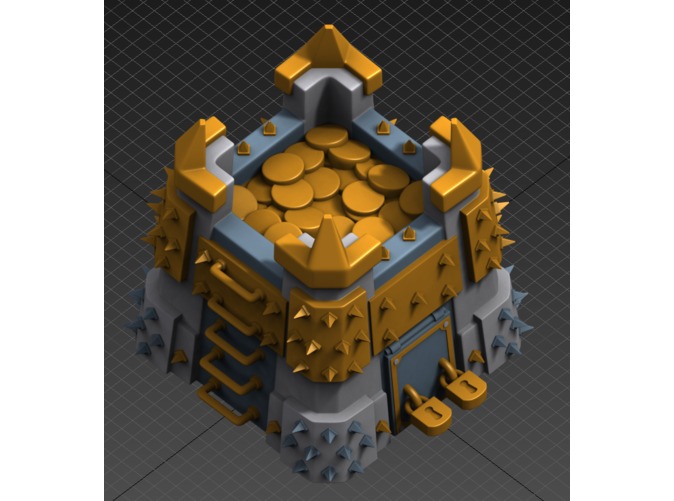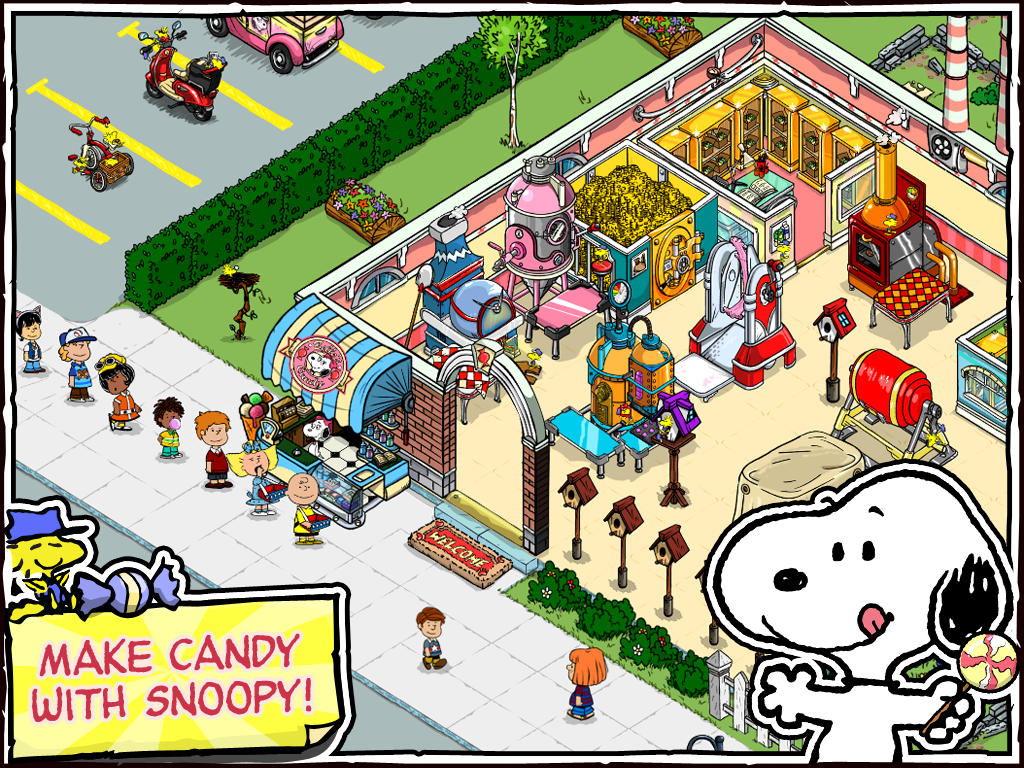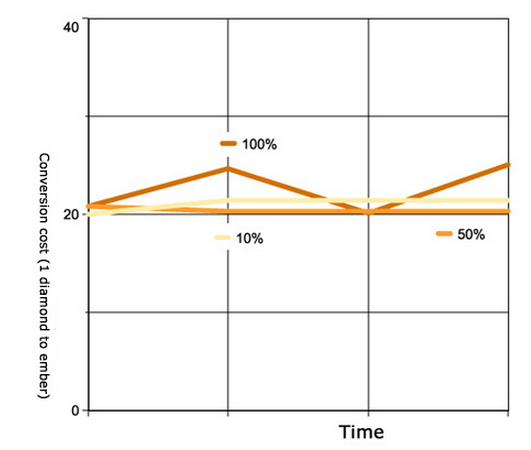Converting currencies in F2P games
Yesterday on the pages PocketGamer.biz John Jordan’s interesting material has appeared about how game developers play with currency rates in their F2P titles. We offer a short retelling with explanations and additions.
In shareware games, as a rule, there are two types of currencies.
The first type of currency is called non-convertible (or soft). The player actively interacts with her all the time, receiving her for completing tasks, knocking out monsters, collecting on beds, and also spends her later on building houses, hiring troops, weapons or anything else. There are often several such currencies in the game. It can be gold, wood, stone.
The second type of currency is called hard currency. This currency is used in the game to accelerate any action, as well as to buy soft currency. As a rule, hard currency is bought for real money. It is very difficult to get it in the game itself. Often these are all sorts of diamonds, crystals.
In an ideal situation, cutting hard currency out of the game when the balance changes should not affect the gameplay. This, by the way, correlates with the popular statement that, first of all, you need to think about the gameplay, make it logical, closing into a cycle, and only then load it with monetization.
The meaning of hard currency for the player, as a rule, is the opportunity to get more pleasure from the project, speeding up progress. One of the acceleration options is the purchase of unearned resources. The advantage of such monetization is that the project itself does not lose its balance.
But there is a difficulty – how to calculate the value of a soft currency in relation to a hard one?
The simple answer is to make the price of a soft currency to a hard one constant. For example, 100 trees = 1 diamond. And so it is throughout the game.
This approach is almost never used. According to John, the following scheme is used in most projects.
The player has a so-called storage. For example, in Clash of Clans there are as many as three soft currencies and, accordingly, three types of storage: gold storage, elixir storage and dark elixir storage. Each player can fill 10%, 50% and 100% for crystals.
In each case, the price of one unit of soft currency to one unit of hard currency is different. This is done to stimulate the purchase in which the developer is most interested.
The more profitable a certain purchase is, the more often players will resort to it. But it is clear that a certain balance is needed, a game with the rates of domestic currencies.
As the first example, John Jordan cites the time manager of Snoopy Candy Town from Capcom and Beeline, where gold acts as a non-convertible currency, and Beagle Bucks acts as a hard currency.
As in many similar games, Snoopy Candy Town allows you to replenish gold reserves by a different number of percentages (by 10%, 50% or 100%).
It is clear that along with the player’s progress, the storage capacity of non-convertible currency is also growing, as well as the required amount of hard currency to replenish stocks by an appropriate number of percent.
As we have already noted, depending on how much the player wants to replenish the reserves of soft currency, the exchange rate of hard currency changes.
This is especially noticeable on the example of the curve reflecting the conversion of purchases of 10% replenishment of the storage. As you can see, it stands somewhat apart from other straight lines. There are two reasons for this. Firstly, this is the best deal. Secondly, it costs only 1 Beagle Bucks to fill the storage by 10% (the minimum possible price tag for a game purchase).
Conversion Factor in Snoopy Candy Town
(1 buck to gold/time)
But, as you can see on the graph, the conversion rate for a payment that replenishes the storage by 50% and 100% is about the same.
The second example is Dungeon Keeper.
Unlike Snoopy Candy Town, this game uses a different system of replenishment of non–convertible currency – 25%, 50% and 100%. Because of this, its curves are less isolated.
Conversion Factor in Dungeon Keeper
(1 diamond to gold/time)
Plus, unlike the Capcom project, the player receives the largest amount of non-convertible currency for one unit of hard currency if he replenishes the storage by 100%. In Snoopy Candy Town, as we already know, it’s the opposite.
Another difference between Dungeon Keeper is that the game has two non–convertible currencies – gold and stones. In terms of conversion, there is no difference between them. The worst deal is buying 200 gold/200 stones for 1 diamond (hard currency in the game).
Conversion Factor in Dungeon Keeper
(1 diamond to stones/time)
The graph shows significant changes in conversion – about twice every three weeks. This means that the players did not convert diamonds into soft currency at the first stages, and began to resort to this only after upgrading their vaults.
The third example is Heroes of Honor from Nonstop Games. As in the case of Dungeon Keeper, there are two soft currencies that are most profitable to buy, filling the vault by 100%.
It is curious that if the situation with the conversion of the tree resembles a similar one in Dungeon Keeper:
Conversion Factor in Heroes of Honor
(1 crystal to a tree/time)
.. then in the case of the second currency (gold), everything is different.
Conversion Factor in Heroes of Honor
(1 crystal to gold/time)
Before the upgrade, interest in this currency is low at a certain stage, but then it reaches high values. It is quite possible that the reason lies in some imbalance (in the early stages, gold is a less important resource or is obtained with less difficulty than wood).
The situation is also different in JuiceBox’s HonorBound. In this role-playing game, the conversion between soft currency gold and hard currency diamonds is permanent in the case of 10% replenishment, with 50% it acquires the same character when the player reaches a certain level.
Conversion factor to HonorBound
(1 diamond to gold/time)
With the second soft currency, everything is completely different. Compared to other games, the difference between gold is minimal, and the conversion is very small.
Conversion factor to HonorBound
(1 diamond to ash/time)
In Epic Empire, the purchase price is generally fixed. One starstone is worth 41 gold throughout the game. It doesn’t matter if you replenish the storage by 10%, 50% or 100%.
Conclusion
The bottom line is that the change in the price of a soft currency relative to a hard currency, depending on the volumes purchased, is an excellent tool for controlling IAP.
How to calculate the exchange rate of a soft currency to a hard one is a matter for each company individually. But here it is necessary to take into account a huge number of variables that affect in each individual case the ratio of the price of 1 diamond to N values of a soft currency.
- replenished %;
- the maximum number of resources in storage (the calculation of the replenished % comes from the maximum location);
- how much currency is currently in the vaults;
- the ratio of soft currencies to each other (usually 1 to 1, but not always, for example, in Clash of Clans, the dark elixir is more expensive than usual).
Of course, as already mentioned, you can abandon these calculations and make the relationship permanent, but this way you will definitely not increase your income from the project.
P.S.
And on the chart, just below the ratio of gaming hard currencies with a dollar price tag. It can be used to estimate the dynamics of the cost of storage replenishment by 100% in terms of real money.
Dynamics of dollar prices of 100% replenishment of soft currency storage in F2P games
Source: http://www.pocketgamer.biz









